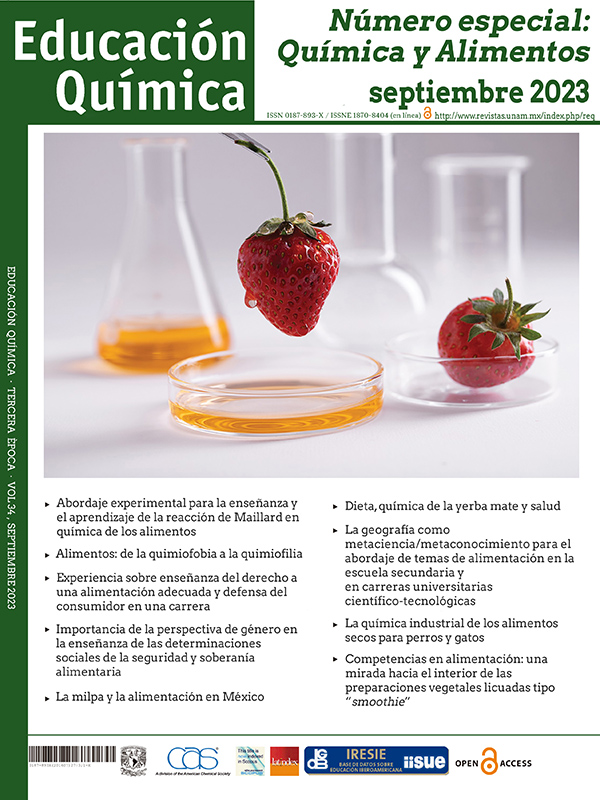Experimental approach for teaching and learning the Maillard reaction in food chemistry
Main Article Content
Abstract
The color of food is one of the first attributes perceived by the consumer and is associated with taste and preservation state. The Maillard reaction is a complex process that generates colors, ranging from yellow to dark brown, aromas, and tastes characteristic of cooked foods containing carbohydrates and amino acids or proteins. This work analyzes possible experimental approaches for teaching and learning the Maillard reaction, based on experience in the Food Chemistry course. The topic was experimentally approached in two instances, the first with a simplified system (samples in test tubes) and the second in a real system (sweet cookies). The studied effects were the type and concentration of sugar, pH, and time and temperature of cooking. From the simplified systems, it is expected that students will be able to explain and justify the observed results considering the theory. In the real system, the purpose is to achieve learning that allows students to explain phenomena of their daily life. In addition, a third activity is proposed, where they can put into practice the knowledge and skills acquired to experimentally solve an integrative problem with a non-standardized protocol.
Article Details
Citas en Dimensions Service
References
Avargil, S. (2019). Learning chemistry: Self-efficacy, chemical understanding, and graphing skills. Journal of Science Education and Technology, 28(4), 285-298.
BaduiDergal, S. (2016). Química de los alimentos. México, Pearson Educación.
Berrio, A. T. (2009). La experimentación dirigida como método eficaz de la investigación y del aprendizaje significativo [Proyecto aplicado, Universidad Nacional Abierta y a Distancia, UNAD]. Repositorio Institucional UNAD.
Carrascosa Alís, J., Gil Pérez, D., Vilches Peña, A., & Valdés Castro, P. (2006). Papel de la actividad experimental en la educación científica. Caderno Brasileiro de Ensino de Física, 2006, vol. 23, núm. 2, p. 157-181.
Damodaran, S., & Parkin, K. L. (Eds.). (2017). Fennema’s food chemistry. Fifth edition. CRC press.
Diederen, J., Gruppen, H., Hartog, R., & Voragen, A. G. (2006). Design and evaluation of digital assignments on research experiments within food chemistry. Journal of Science Education and Technology, 15, 227-246.
Fernández, C. L., & Aguado, M. I. (2017). Aprendizaje basado en problemas como complemento de la enseñanza tradicional en Fisicoquímica. Educación Química, 28(3), 154-162.
Kravchuk, O., Elliott, A., & Bhandari, B. (2005). A laboratory experiment, based on the maillard reaction, conducted as a project in introductory statistics. Journal of Food Science Education, 4(4), 70-75.
Landau, L., Ricchi, G., & Torres, N. (2014). Disoluciones:¿Contribuye la experimentación a un aprendizaje significativo? Educación química, 25(1), 21-29.
León Cedeño, F., & Jiménez Curiel, C. D. C. (2022). Experiencias docentes durante la pandemia= Curso experimental. Educación Química, 33(2), 82-93.
Rivera Monroy, A. M. (2016). La experimentación como estrategia para la enseñanza aprendizaje del concepto de materia y sus estados. Trabajo de Maestría. Universidad Nacional de Colombia. Departamento de Matemáticas y Estadística.https://repositorio.unal.edu.co/handle/unal/59111
Séré, M. G. (2002). La enseñanza en el laboratorio:¿qué podemos aprender en términos de conocimiento práctico y de actitudes hacia la ciencia? Enseñanza de las Ciencias, 20(3), 357-368.

Educación Química por Universidad Nacional Autónoma de México se distribuye bajo una Licencia Creative Commons Atribución-NoComercial-SinDerivar 4.0 Internacional.
Basada en una obra en http://www.revistas.unam.mx/index.php/req.




